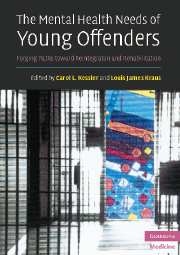Book contents
- Frontmatter
- Contents
- List of contributors
- Foreword
- Acknowledgments
- 1 An overview of child and adolescent mental health needs in the juvenile justice system
- 2 Psychiatric disorders of youth in detention
- 3 Disproportionate minority confinement
- 4 Police interrogation of youth
- 5 Assessing children's competence to stand trial and to waive Miranda rights: new directions for legal and medical decision-making in juvenile courts
- 6 The etiology of antisocial behavior: biopsychosocial risk factors across development
- 7 Substance abuse in youth offenders
- 8 Suicide and delinquent adolescents
- 9 Juvenile sex offenders
- 10 Educational needs of youth in the juvenile justice system
- 11 Science and the juvenile death penalty
- 12 Medical issues regarding incarcerated adolescents
- 13 Mental health screening and assessment in juvenile justice
- 14 Psychological testing in juvenile justice settings
- 15 Psychopharmacology and juvenile delinquency
- 16 Evidence-based treatment for justice-involved youth
- 17 Community alternatives to incarceration
- 18 Innovative problem-solving court models for justice-involved youth
- 19 Ethical issues of youthful offenders: confidentiality; right to receive and to refuse treatment; seclusion and restraint
- 20 Post-adjudicatory assessment of youth
- Index
- References
16 - Evidence-based treatment for justice-involved youth
Published online by Cambridge University Press: 11 August 2009
- Frontmatter
- Contents
- List of contributors
- Foreword
- Acknowledgments
- 1 An overview of child and adolescent mental health needs in the juvenile justice system
- 2 Psychiatric disorders of youth in detention
- 3 Disproportionate minority confinement
- 4 Police interrogation of youth
- 5 Assessing children's competence to stand trial and to waive Miranda rights: new directions for legal and medical decision-making in juvenile courts
- 6 The etiology of antisocial behavior: biopsychosocial risk factors across development
- 7 Substance abuse in youth offenders
- 8 Suicide and delinquent adolescents
- 9 Juvenile sex offenders
- 10 Educational needs of youth in the juvenile justice system
- 11 Science and the juvenile death penalty
- 12 Medical issues regarding incarcerated adolescents
- 13 Mental health screening and assessment in juvenile justice
- 14 Psychological testing in juvenile justice settings
- 15 Psychopharmacology and juvenile delinquency
- 16 Evidence-based treatment for justice-involved youth
- 17 Community alternatives to incarceration
- 18 Innovative problem-solving court models for justice-involved youth
- 19 Ethical issues of youthful offenders: confidentiality; right to receive and to refuse treatment; seclusion and restraint
- 20 Post-adjudicatory assessment of youth
- Index
- References
Summary
The past ten years have seen a rapid increase in the development of evidence-based interventions for youth; however, many challenges remain. These factors include the challenges associated with service delivery, the importance of initial engagement, and the complex nature of the problem (Wasserman et al., 2000). On the other hand, treatment research in this area (and the more global child and adolescent treatment research) has moved considerably toward recognizing the need for “empirically supported” treatment. In 1995, the American Psychological Association Division 12 Task Force on Promotion and Dissemination of Psychological Procedures was charged with the task of identifying treatment approaches with demonstrated “efficacy.” Efficacy refers to the ability to bring about the desired change under ideal conditions, and an efficacious program is one with scientific evidence demonstrating positive changes among those who receive the treatment. This term is contrasted with the word “effective,” which refers to the likelihood that a person will comply with a given treatment. An effective program has the ability to produce positive change in the general population. In a comprehensive review of the literature, the APA's Task Force (Levant, 1995) established the validity of numerous treatment approaches. They applied the terms “empirically validated” or “empirically supported” and “probably efficacious” to represent therapeutic approaches with varying degrees of scientific evidence.
The list of therapies deemed valid or “well-established” and probably efficacious was updated in 1998 (Chambless et al., 1998) and again in 2001 (Chambless & Ollendick, 2001).
Keywords
- Type
- Chapter
- Information
- The Mental Health Needs of Young OffendersForging Paths toward Reintegration and Rehabilitation, pp. 340 - 367Publisher: Cambridge University PressPrint publication year: 2007
References
- 8
- Cited by



